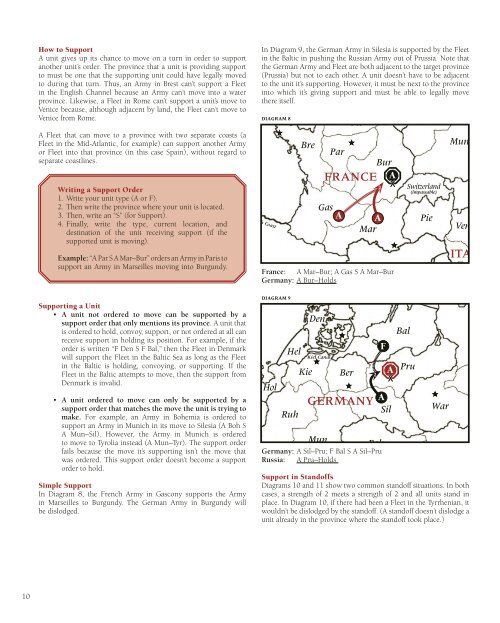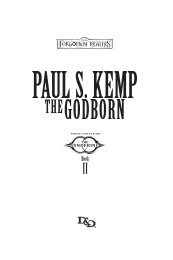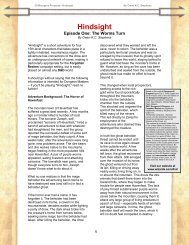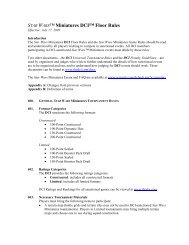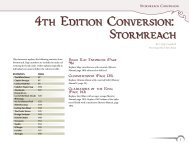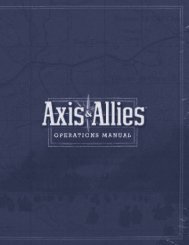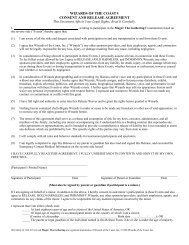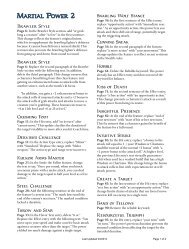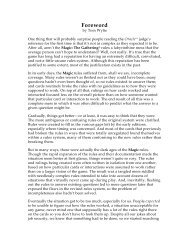Diplomacy Rulebook - Wizards of the Coast
Diplomacy Rulebook - Wizards of the Coast
Diplomacy Rulebook - Wizards of the Coast
Create successful ePaper yourself
Turn your PDF publications into a flip-book with our unique Google optimized e-Paper software.
How to Support<br />
A unit gives up its chance to move on a turn in order to support<br />
ano<strong>the</strong>r unit’s order. The province that a unit is providing support<br />
to must be one that <strong>the</strong> supporting unit could have legally moved<br />
to during that turn. Thus, an Army in Brest can’t support a Fleet<br />
in <strong>the</strong> English Channel because an Army can’t move into a water<br />
province. Likewise, a Fleet in Rome can’t support a unit’s move to<br />
Venice because, although adjacent by land, <strong>the</strong> Fleet can’t move to<br />
Venice from Rome.<br />
In Diagram 9, <strong>the</strong> German Army in Silesia is supported by <strong>the</strong> Fleet<br />
in <strong>the</strong> Baltic in pushing <strong>the</strong> Russian Army out <strong>of</strong> Prussia. Note that<br />
<strong>the</strong> German Army and Fleet are both adjacent to <strong>the</strong> target province<br />
(Prussia) but not to each o<strong>the</strong>r. A unit doesn’t have to be adjacent<br />
to <strong>the</strong> unit it’s supporting. However, it must be next to <strong>the</strong> province<br />
into which it’s giving support and must be able to legally move<br />
<strong>the</strong>re itself.<br />
DIAGRAM 8<br />
A Fleet that can move to a province with two separate coasts (a<br />
Fleet in <strong>the</strong> Mid-Atlantic, for example) can support ano<strong>the</strong>r Army<br />
or Fleet into that province (in this case Spain), without regard to<br />
separate coastlines.<br />
Writing a Support Order<br />
1. Write your unit type (A or F).<br />
2. Then write <strong>the</strong> province where your unit is located.<br />
3. Then, write an “S” (for Support).<br />
4. Finally, write <strong>the</strong> type, current location, and<br />
destination <strong>of</strong> <strong>the</strong> unit receiving support (if <strong>the</strong><br />
supported unit is moving).<br />
A<br />
2<br />
A<br />
A<br />
Example: “A Par S A Mar–Bur” orders an Army in Paris to<br />
support an Army in Marseilles moving into Burgundy.<br />
Supporting a Unit<br />
• A unit not ordered to move can be supported by a<br />
support order that only mentions its province. A unit that<br />
is ordered to hold, convoy, support, or not ordered at all can<br />
receive support in holding its position. For example, if <strong>the</strong><br />
order is written “F Den S F Bal,” <strong>the</strong>n <strong>the</strong> Fleet in Denmark<br />
will support <strong>the</strong> Fleet in <strong>the</strong> Baltic Sea as long as <strong>the</strong> Fleet<br />
in <strong>the</strong> Baltic is holding, convoying, or supporting. If <strong>the</strong><br />
Fleet in <strong>the</strong> Baltic attempts to move, <strong>the</strong>n <strong>the</strong> support from<br />
Denmark is invalid.<br />
• A unit ordered to move can only be supported by a<br />
support order that matches <strong>the</strong> move <strong>the</strong> unit is trying to<br />
make. For example, an Army in Bohemia is ordered to<br />
support an Army in Munich in its move to Silesia (A Boh S<br />
A Mun–Sil). However, <strong>the</strong> Army in Munich is ordered<br />
to move to Tyrolia instead (A Mun–Tyr). The support order<br />
fails because <strong>the</strong> move it’s supporting isn’t <strong>the</strong> move that<br />
was ordered. This support order doesn’t become a support<br />
order to hold.<br />
Simple Support<br />
In Diagram 8, <strong>the</strong> French Army in Gascony supports <strong>the</strong> Army<br />
in Marseilles to Burgundy. The German Army in Burgundy will<br />
be dislodged.<br />
France: A Mar–Bur; A Gas S A Mar–Bur<br />
Germany: A Bur–Holds<br />
DIAGRAM 9<br />
Germany: A Sil–Pru; F Bal S A Sil–Pru<br />
Russia: A Pru–Holds<br />
Support in Stand<strong>of</strong>fs<br />
Diagrams 10 and 11 show two common stand<strong>of</strong>f situations. In both<br />
cases, a strength <strong>of</strong> 2 meets a strength <strong>of</strong> 2 and all units stand in<br />
place. In Diagram 10, if <strong>the</strong>re had been a Fleet in <strong>the</strong> Tyrrhenian, it<br />
wouldn’t be dislodged by <strong>the</strong> stand<strong>of</strong>f. (A stand<strong>of</strong>f doesn’t dislodge a<br />
unit already in <strong>the</strong> province where <strong>the</strong> stand<strong>of</strong>f took place.)<br />
2<br />
F<br />
A<br />
A<br />
10


